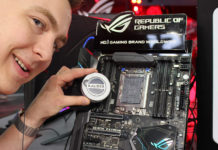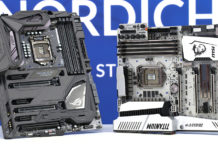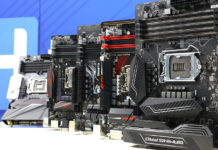ASUS P5Q3 Deluxe is based on the upcoming Intel P45 chipset. We’ve gotten a chance to test one of the first functioning motherboards and today we present this review where we compare it to previous generations of Intel chipsets.
There is an expression that reads “the bigger, the better” and ASUS is without question the biggest when it comes to motherboards, but is it the first to present a motherboard based on the P45 circuit? P45 is the successor to P35, and, according to Asus, the motherboard we’ve been handed is one of the first in the world that actually works. P45 and its precursors land in a market segment somewhere between the high performance circuits and the slower models for built-in systems. To call this circuit mid-range is actually an understatement, from a performance and equipment perspective. When the big motherboard manufacturers get to do what they want, the performance is identical to its bigger brothers and the equipment at least as equally exclusive.

In this review, we will take a closer look at ASUS P5Q3 Deluxe, which is based on Intel’s P45 chipset. The difference in performance between the P35 and its precursor P965 was minimal; the question is whether the P45 has any additional performance advantages. An important difference between P35 and P45 is that the latter is made using the 65nm manufacturing process, while the former was made with the 90nm process. This, if anything, should give the possibility of higher system bus speeds. Can the P5Q3 with its Deluxe version also give the consumer some added value in the form of additional features?
Let’s present Asus P5Q3 Deluxe.
 | |
Asus P5Q3 Deluxe – Specifications | |
| Processor support | Intel Socket 775: Core 2 Extreme, Core 2 Duo, Core 2 Quad, Pentium Extreme Edition, Pentium D, Pentium 4, Celeron |
| Chipset | Intel P45 / ICH10 |
| System bus | 1600/1333/1066/800 FSB |
| Memory | 4x 240-pin DIMM Dual DDR3 1600/1333/1066/800 channels Maximal 8GB |
| Expansion slots | 3x PCI-Express x16 (1×16 or 2×8) 2x PCI-Express x1 2x PCI |
| Storage | 1x Floppy drive 1x Ultra DMA 133/100/66/33 IDE 8x SATA 3G (RAID 0/1/0+1/5/JBOD) (one external) |
| Internal connections | 4x USB 1x IEEE 1394 (Firewire) 1x COM port 1x FrontAudio 1st CD/AUX input |
| External connections | 1x PS/2 Keyboard/mouse 2x S/PDIF Ut (Coax + optical) 1x IEEE 1394 (Firewire) 1x SATA 6x 2.5mm audio connectors (7.1) 2x RJ-45 (10/100/1000Mbit) 6x USB |
| Size | 305 x 244mm |
| Other | Wireless LAN |
| Price | €199 |
The list is pretty much complete; triple network interfaces, whereof one wireless, 8 channel HD audio with two digital connectors (in and out), external SATA, and as expected USB and Firewire. With this set of features ASUS has been able to include almost every possible user and area of use. The board has three PCI-Express 16x slots, where the top slot can be configured to use sixteen PCI-Express 2.0 lanes, or that the two upper slots share the lanes in a 2×8 configuration.
Our board is an early sample and it doesn’t have all of the accessories that will be sent along with the retail card, but we assume that all of the essential accessories will be there.
Let’s move on and take a closer look at the board.
Overall, P5Q3 has a decent layout. No bulky components, odd placements of the connectors or such. The SATA ports are angled where there’s a chance long graphics cards will be in the way for a regular up-right SATA connector. The internal connections are gathered in the lower portion of the board and the ATX feed and floppy connectors are placed in the top right corner. As you can see, the rear connectors are organized as we would expect and the two lower jacks are antenna connectors for the wireless network interface.
The cooling is sturdy, but not exaggerated. Heatpipe cooling for the southbridge is unnecessary in most cases, but it doesn’t intrude in this case. Further more, the board has dual heatpipes for removing the heat from the northbridge. The heatsinks on the MOSFET transistors are screwed in place instead of held down by regular push-pins, which gives a much better impression, pressure and heat deduction.
Here we have an overview of the power circuitry for the processor and memory. The processor has a 16-phase power supply, which is twice the capacity of previous ASUS boards. The number of phases is in no way an indication of performance, but it suggests a rigorous design. What’s even more unusual are the two 3-phase power supplies for both memory and northbridge, which also suggests stable voltages for both of them.
Now that the board has been presented, it’s time to take a look at the other components of the test system.
 | ||
Test system | ||
| Hardware | ||
| Motherboards | ASUS P5Q3 Deluxe ASUS P5E3 Premium ASUS P5K-E | |
| Processor | Intel Core 2 Extreme QX9770 3.2GHz (2x6MB) | |
| Memory | Corsair Twin3X 12800C7 DHX (2048MB) Corsair 8500C5D Dominator (2048MB) | |
| Graphics cards | NVIDIA GeForce 8800GTX | |
| Power supply | Silverstone Olympus 1200W | |
| Software | ||
| Operating system | Windows XP (SP2) | |
| Drivers | Intel Chipset Driver 9.0.0.1007 Intel Chipset Driver 8.3.0.1013 NVIDIA Forceware 158.22 | |
| Benchmarks | EVEREST Ultimate Edition 4.00.976 SuperPi 1.5 wPrime 1.52 Cinebench 9.5 Lame 3.97 WinRAR 3.70 3DMark2001 3.3.0 3DMark03 3.6.0 3DMark05 1.2.0 3DMark06 1.0.2 PCMark05 1.1.0 FarCry 1.33 Doom 3 Quake 4 | |
For reference we have ASUS P5E3 Premium, which is based on Intel X48 and DDR3, and ASUS P5K-E, which is based on P35 and DDR2. Today’s motherboards and chipsets have a broad spectrum of memory specifications we have to consider, which leads to a big gap in performance depending on the settings. To be as fair as possible, we’ve forced the same settings with the two DDR3 platforms, as seen below.
One setting that is not present on P5Q3 is Command Rate and it remains to be seen if this setting will arrive with newer BIOSes for P45 boards.
First we have some synthetic tests.
There’s not much separating the boards. P5E3 brings home all tests, closely followed by P5Q3. The DDR2 platform and P5K-E is defeated in all tests but the AES test where it manages to beat both DDR3 boards.
SuperPi and wPrime are next.
SuperPi is very sensitive to system performance and we can see that P5Q3 is on par with P5E3, but it might take some tweaking before P45 can go up against X48.
Let’s look at Cinebench and WinRAR.
Once again, with a minimal margin of a mere percent or two, the boards show almost identical results.
We look at how the motherboards perform in 3DMark.
Here we see a small change in tendency. P5Q3 manages to claim some rounds from P5E3 in a very interesting battle between the DDR3 boards. P5K-E is once again left behind and is clearly slower than the DDR3 system.
We look at 3DMark 06’s CPU test and PCMark next.
3DMark 06’s CPU test is won by P5Q3, while we see the old patterns in the other tests.
We finished with some games on the next page.
Things are finally coming into place for P5Q3 which brings home the win in all of the game tests. If we didn’t know any better, we would suspect that ASUS has optimized the board for gaming.
Before we close this article, we’ll look at the overclocking of the board.
A new chipset, not to mention the die-shrink, always brings a few new interesting features to test. One of these is of course overclocking the system bus. Because of the deadline for this review, we never got hold of a dual-core 45nm CPU to test leaving us with a quad-core ditto, namely QX9770.
Overclocking the system bus really high isn’t easy for a motherboard because of the two separate pairs of cores. You have to fine tune the reference voltages that in turn are related to a whole lot of other voltages and frequencies. It is far from the usual the higher voltage, the better. At the same time Intel has released CPUs with an initially higher bus frequency and locked multipliers, leaving the overclocking limit to how high your system bus can go. After a whole lot of tweaking, this is what we achieved:
495MHz FSB was no real problem, but 500 turned out to be more of a challenge. To reach it was no problem, but to run the system stable at this frequency took a whole lot of time. Finally, we managed to find the optimal voltages to run Folding@Home over a longer course of time. As we speak, we’re past the 24 hour stability limit, which usually means that the system is stable to run for a lot longer if needed to. ”This test was conducted with only air cooling on the CPU and the stock cooler on the northbridge. No extreme voltages were used either.
As mentioned above, it’s hard to get all of the reference voltages just right, when you’re overclocking a quad-core processor. In the same way, it’s a challenge for the motherboard manufacturers to design the bus between the memory and northbridge, which includes the communication between different processes working at different voltages. At high frequencies and with relatively long physical distances between the actual memory modules and the northbridge it’s important to match the impedances between all lanes. This problem is partly something the people doing the layout and partly something the people tuning the northbridge has to deal with. ASUS has been working hard on optimizing both of these things and now have a feature called Memory OC Charger in the BIOS, which is suppose to optimize the settings depending on the memory frequency. This is something we will investigate further in coming articles.
|
|
We hope to return with a more in-depth overclocking review with both dual and quad-core processors in the future.
Lastly, let’s sum up our impressions of the board.
Performance
The chipset manufacturers haven’t exactly spoiled us with major performance improvements with the last couple of iterations. Intel’s system bus architecture has been around for a couple of years now and we seem to have reached a point where the performance is as good as it can get. As you can see in our benchmarks, DDR3 offers a slight advantage over DDR2, but it’s also worth mentioning that P45 performance is on par with X48, which is a considerably more expensive chipset.
Overclocking
ASUS P5Q3 has tons of voltage settings and configuration possibilities, and should prove to be a good platform for overclocking. We weren’t completely satisfied with the settings available with P5K-E, which has been fixed with this board. The power supply for processor, memory and northbridge are among the most powerful we’ve seen and the high-quality components tends for superior overclocking, something we will investigate further in a future article. The cooling is well adjusted for the task at hand and despite heavy load, we haven’t noticed any problems with overheating.
Product value
The Deluxe versions from ASUS usually ship with a lot of features and P5Q3 Deluxe is no exception. We suspect that this board will be able to satisfy most people. The amount of features are equivalent to most, more expensive, boards based on the X48 chipset, while offer identical performance. The thing that separates P45 from X48 is the number of PCI-Express lanes, where X48 offers twice as many for the graphics cards. The board is not available in stores yet, but the price is on par with most other similar boards.
Conclusion
ASUS P5Q3 Deluxe is a very attractive motherboard based on the very latest of Intel’s chipsets, P45. The motherboard shares a number of features with its bigger and more expensive siblings, while at the same time offering the same level of performance. The build quality is solid and the various hardware configurations we’ve tested have all been fully stable. The overclocking with today’s 45nm quad-core processors is quite promising. The only thing missing from getting an Editor’s choice award is an attractive price tag.
 | |
Asus P5Q3 Deluxe | |
Pros Cons | |
We want to thank Asus for sending us this board for evaluation.






































Leave a Reply